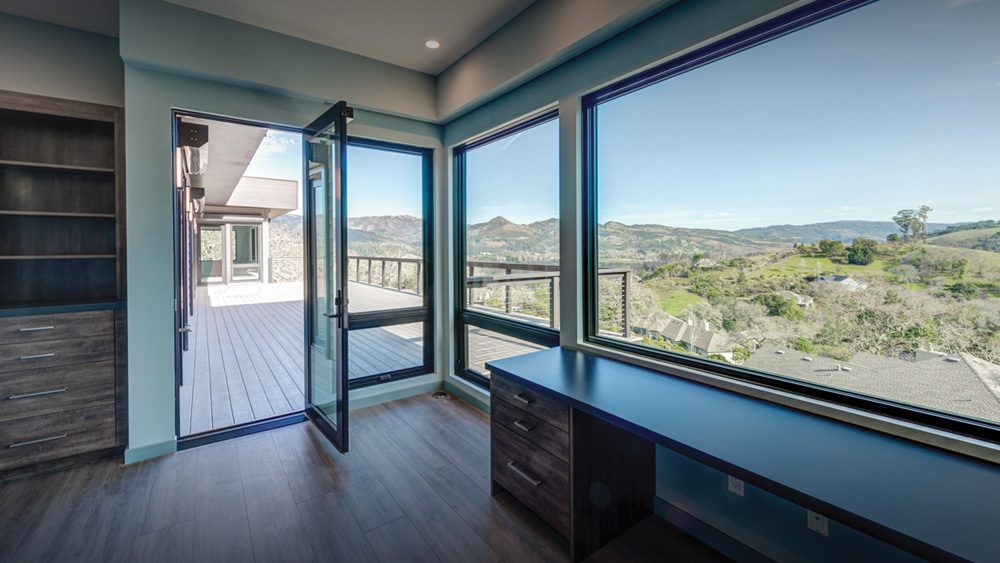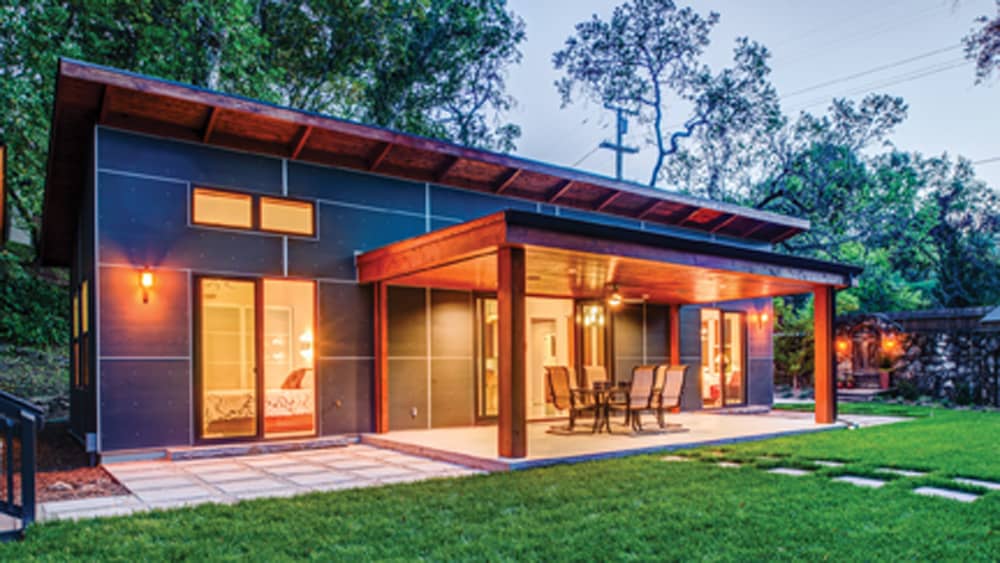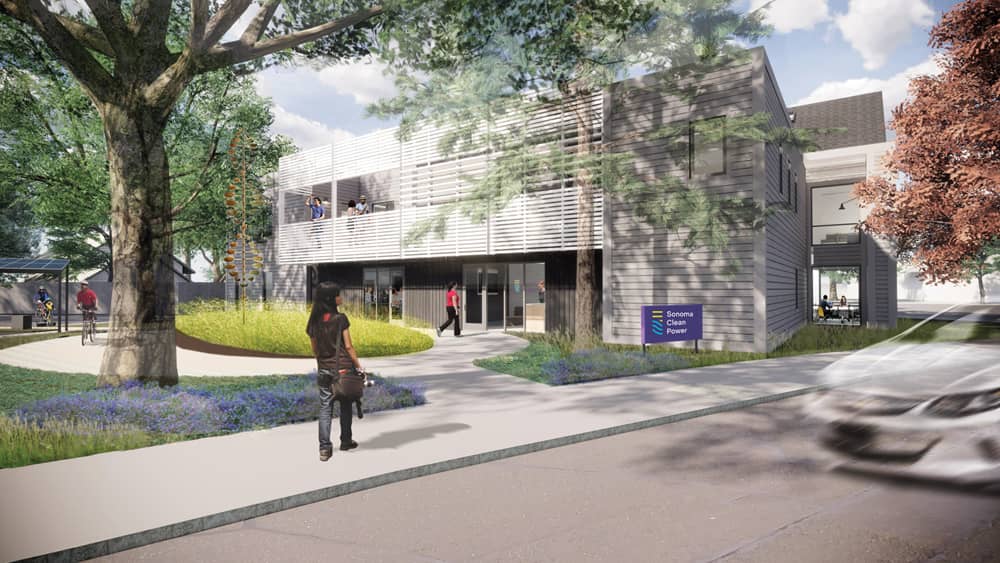
[Treve Johnson Photography]
In 2020, “sustainable” means building plans that protect occupants from a variety of possible dangers, including the novel coronavirus, fire, smoke and power outages. These plans also strive to be eco-friendly. They minimize waste, utilize recovered materials and harvest solar energy whenever possible.
“Across the North Bay, clients are looking to optimize indoor air quality. The second most common thing on everyone’s mind is fireproof design and fire-resistant buildings,” says Michael Heacock, principal at Michael Heacock Architects in Marin. Conversations around sustainability have shifted focus from energy and water conservation to life-preserving tactics that maximize occupant health and safety, says Heacock. “We’re seeing a new focus in priorities, with commercial owners upgrading HVAC systems and installing intelligent occupancy sensors to monitor room density,” he says.
While commercial property construction projects have been scaled back or stalled, the demand for new residential construction and renovation has jumped. New buyers and owners of second homes moving permanently to the North Bay are transforming vacation residences into year-round living spaces. They’re spending hundreds of thousands of dollars to create a social bubble for children and older adults. Many owners are interested in adding accessory dwelling units (ADUs), attached and detached home offices, and solar panels and batteries to power through public safety power shutoffs and fires.
“A number of our last few projects were fire rebuilds. As part of the design approach, they included a focus on energy efficiency, with top-quality insulation, a good heating and cooling system, comfort and maintaining healthy indoor air quality,” says Dave Leff, founder of Leff Construction Design Build, a general contracting firm in Sebastopol. Skilled professionals find ways to combine sustainability goals, according to Leff. “Best practices involve placing the glazing on the south and east sides of the house when the property allows it. This approach takes advantage of the passive solar opportunities for managing heating and cooling. It helps to reduce the amount of money the occupants have to spend on conditioning (heating and cooling) of their house,” he says.
“Glazing” refers to the number of panes of glass in a window. It also refers to the process of sealing the window with putty, coating the faces of the glass with special materials and filling the space between glass panes with an inert gas such as argon or xenon. All of these measures increase a home’s energy efficiency because they reduce heat and light loss.
Using materials to increase safety
Marin, Napa and Sonoma counties have a long tradition of sustainable buildings. Two examples are the communal, environment-inclusive design of Sea Ranch, which was constructed in 1964, and Aaron Green’s design for the underground jail at the Marin County Civic Center. This structure plays off the architecture of Frank Lloyd Wright and was built in 1994.
Driving on residential streets and two-lane highways offers an informal tour of different designs, from restored 1970s geodesic domes to the living roof at the Ellis Creek Water Recycling Facility in Petaluma.
Bruce King, a structural engineer, says one of the most promising sustainable building trends in the North Bay is natural building. “Natural building is a subset of green building that utilizes what is nearby and at hand, rather than burn fossil fuels to gather and transform building materials,” he says.
King is also the director of Ecological Building Network, a nonprofit research network based in San Rafael. He favors straw bale and hempcrete—the latter being a mixture of lime plater and hump hurds—for insulating, fire-resistant walls.
He used a number of these materials on one of his best-known projects, the Real Goods Solar Living Center in Hopland. King says natural materials and labor costs involving them can be slightly more than conventional systems. Yet they allow property owners and cities to minimize fire risk.
“Wood frame houses are ideally suited to burn. Straw bale and hemp walls are tightly bound and more fire-resistant,” says King. “They can charr on the outside, but there’s no oxygen to support fire.”
Solar and battery power
One of the keys to creating a sustainable structure is a careful review of site placement and building massing. Site placement provides opportunities for sun control, which might include solar arrays and shade management. Site placement also allows for the potential preservation of natural resources. “The Roseland School District office is one of our recent designs. It shows what you can do when you situate the long axis east to west to better control the south-facing sunlight and capitalizing on north-facing views,” says Doug Hilberman, principal at AXIA Architects in Santa Rosa.

“This helps reduce energy use. We also utilized a lot of recycled materials, locally-sourced materials and low-flow plumbing fixtures. These combine to create a handsome building and helps reduce the depletion of natural resources,” says Hilberman.
Ted Walsh, CEO and partner in SolarCraft, a solar power contractor with offices in Novato and Sonoma, says a property owner should choose a responsibly-sized system. “The goal is to make sure the system generates the right amount of renewable energy for the home or office. Over the years, we have seen many instances of other solar contractors selling property owners systems that generate much more or less power than they need. This often benefits the power company more than the property owner,” says Walsh.
Walsh says with a cost-effective, appropriately-sized system, a property owner can used saved money to invest in a battery-backup system, such as an Enphase Encharge or Tesla Powerwall. They can also outfit a home with energy-efficient appliances or consider purchasing an electric vehicle (EV). Walsh shared that Enphase Energy is one of the world’s leading solar and battery manufacturers and is based in Petaluma. “In the near future, using an EV to provide backup power for your home will be an exciting and financially compelling option,” he says. “An EV has up to 5 times the battery capacity of a stationary battery system. You also have the daily benefit of driving an EV. [You’re] able to charge it elsewhere and bring the power back to your home and use a specialized charger to keep the lights on in a Public Safety Power Shutoff.”
According to Walsh, a skilled energy consultant will use optimal solar equipment to fit more solar panels on a roof. They will also recommend microinverters that allow the solar panels to operate independently when a tree or structure partially shades the roof at certain times of the day.
He says an energy consultant is key to understanding how solar panels are affected by smoke, rain, grey skies, fire retardant dropped during firefighting efforts and debris such as leaves. “Smoke can reduce a system’s performance by 10 percent. If ash or that red fire retardant gets on panels, that needs to be cleaned off with a squeegee for the panels to work well again. Solar panels might be less visible sitting flat on a roof. If they’re tilted up even five degrees, they can absorb more sunlight. Also, the rain will run off them more easily and keep them cleaner,” says Walsh.

Jonas adds that buildings without an ideal roof for solar panels can benefit from ground mounts which are easier to clean since they are easier to reach. Typically, ground or roof mounts only need to be cleaned once a year. Ground mounts also remain cooler than panels on roofs. “It’s handy to know that cooler panels produce more power than hotter ones in the same sunlight.”
Projects that illustrate perfection
One of the upcoming models for sustainable design is the headquarters of Sonoma Clean Power, the public electric utility company that serves Sonoma and Mendocino counties. Rachel Kuykendall, senior program manager at Sonoma Clean Power (SCP), says the company purchased the 431 E Street property in Santa Rosa to house its administrative operations and staff.
“As we’re making improvements, we’re asking: What does green building mean to us? Like other businesses that want to reduce their carbon and energy footprint, we decided to retrofit an existing space rather than build new. We’re looking at changes that alter how the building is powered to reduce energy use. This building will be all-electric. We want to show sustainable design doesn’t have to be expensive,” says Kuykendall.
SCP’s headquarters is expected to be completed in May 2021. It will have onsite solar and battery storage, car charging stations, all-electric HVAC and water heating and be microgrid capable. SCP plans to use visitor-accessible areas of the office to display energy-efficient appliances and systems, including EV chargers, smart thermostats and heat-pump water heaters.
“We hope to let our 550,000 customers know even with the smoke and the fires, the COVID-19 pandemic, and having to tighten their budgets, small changes really can make a difference,” says Kuykendall. “Every modification or energy-efficient appliance can create a safer home and slow climate change.”
SCP is currently offering up to $4,500 per housing unit in incentives for new carbon-free homes through its Advanced Energy Build program, according to Kuykendall. “This program builds upon the success of our fire rebuild program. Builders and developers throughout Sonoma and Mendocino counties can get incentives for building high-performance homes,” she says.
Joss Hudson, president of EcoSteel Building Systems, a supplier of prefabricated commercial and residential steel buildings based in Laguna Nigel, says EcoSteel is currently building two new models of “micro homes” already in demand in the North Bay. “We’re using a steel frame that’s non-combustible and doesn’t deteriorate. We’re creating modern designs with a focus on compact living,” says Hudson. “Our design for a small building reduces the square footage, creating micro homes that can be built faster and at a fraction of the cost associated with traditional size buildings.”
Hudson says when a building is cut up into different segments, it becomes less energy efficient. “We’re also eliminating unnecessary spaces, such as the foyer, coat closet, and sitting room.” The cleaner design also reduces construction costs. Then property owners can spend more money on features like larger windows or structural overhangs on a roof, which maximize solar gains. “Almost 100 percent of the people who want to build have no idea of what it’s really going to cost. It’s usually double to quadruple what they’re thinking. There’s been a huge construction boom since 2008. I don’t know a contractor in the North Bay who’s building a custom single-family home for under $1 million,” says Hudson.
Creating a new style of compact and non-combustible buildings, says Hudson, means designing a “legacy project” to be handed down to future generations. “With more wildfires and smoke in store in the near future, we’re creating homes and offices that are not vented at the eaves,” he says, explaining that venting in this spot is dangerous. “It allows burning embers to get inside a lumber frame building. We want structures you can pressure test,” says Hudson.
Tailoring structures to the environment
The diverse physical environments of the North Bay teach architects and general contractors what a sustainable design should include. Leff says the moist, salty air and blasting winds of Bodega Bay can be destructive, for instance.
“Your plans should involve windows graded for high wind speeds and stainless steel and copper surfaces that won’t rust. Further inland, around the Russian River, galvanized steel flashing (sheets or strips of water-resistant material that guide water away from the home) is fine. The biggest design issue there is placing the living space above the 100-year flood level. You want to allow floodwater to flow through the structure below the living space,” says Leff.

Hilberman says a Napa structure might focus on cooling strategies and provide refuge from the sun. “You want to encourage the chimney effect,” he says. “This occurs when cool air comes into a home on a first floor or basement. It absorbs heat, rises, and leaves through upstairs windows. This creates a bit of a vacuum and is called ‘passive cooling’. That pulls air in through the bottom of the house again.”
Despite certain microclimate differences, most of the North Bay is a coastal-influenced climate. This climatic zone starts on the east side of the coastal range and continues until the west side of the Napa range.
Kevin Gilleran, president of Gilleran Energy Management, Inc., an energy consulting company in Santa Rosa, says the region’s hot days and cool nights present an opportunity. “At night, we can ‘turn off’ our homes and open them up to cool off if the air quality is good. This is where sustainable designs and high-quality construction can come together to make a real difference,” says Gilleran.
A well-designed “building envelope,” the exterior of the house (specifically windows, doors, walls, ceilings and floors) insulates the occupants inside, says Gilleran. The housing envelope reduces microclimate concerns. “Even in the hills of Cloverdale, which can get pretty hot, you can make design adjustments to create an internal environment that will always be comfortable,” he says. Gilleran added the extreme outdoor temperature swings that this area sees can have a significantly reduced impact to modern well-designed homes.
Brad Heavner, policy director for the California Solar & Storage Association (CALSSA), a trade association for California’s solar energy contractors, says there are an ever-increasing number of ways to make solar panels and batteries part of a green building plan. “In the past decade, the cost of solar panels and batteries have decreased, he says. “The capabilities of these technologies have greatly increased. This presents an excellent opportunity for property owners to integrate reliable, low maintenance technology into offices and homes.”
Heavner says the 2019 public safety power shutoffs and recent fires emphasize the need for alternative energy sources. “Telecommuting during the COVID-19 pandemic caused a lot of the permit processing to go online, which saves costs for customers. Incentives for batteries are currently available.”

According to Gilleran, North Bay energy consultants, local government officials and architects share a common goal. “We’re asking buildings to do more now than they ever have before. We’re looking for ways to protect occupants from catastrophic conditions. As we go forward, locating homes farther away from a wildland-urban interface, conserving water and making buildings more energy-independent, we’re also looking at little things,” says Gilleran.
He says tiny details can be life-saving. One example is including a crank to manually open a garage door in the event of a power failure or shutoff. “We know there is not one simple solution to all the problems,” Gilleran says. “We’re looking for the many solutions that are out there, developing more, and bringing all of them together.”




One thought on “Sustainable & Lifesaving: Sustainable Series Vol. 3”
(The captions and photography credits are missing in this article.)
Reader: The first three images in this article are projects designed and built by LEFF Construction Design Build. https://LeffConstruction.com
The first image is from one of only two fire rebuilds in the Oakmont Village from the 2017 Tubbs Fire. The third image in the article is the entrance to that same house. See this “Oakmont Fire Rebuild” project here: https://leffconstruction.com/recent-projects-completed-leff/
The second image is of a custom home built by LEFF Construction Design Build in Glen Ellen. It did survive the wild fires. See this Glen Ellen Contemporary home here: https://leffconstruction.com/projects/glen-ellen-new-home/
The photographer is Treve Johnson, https://treve-johnson-photography.business.site/?utm_source=gmb&utm_medium=referral
Thank you,
Elaine Lucia
Marketing Director
LEFF Construction Design Build
Sebastopol, CA
LeffConstruction.om